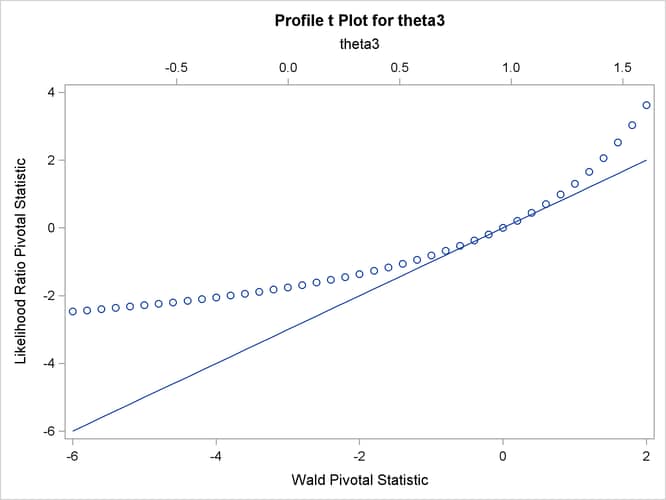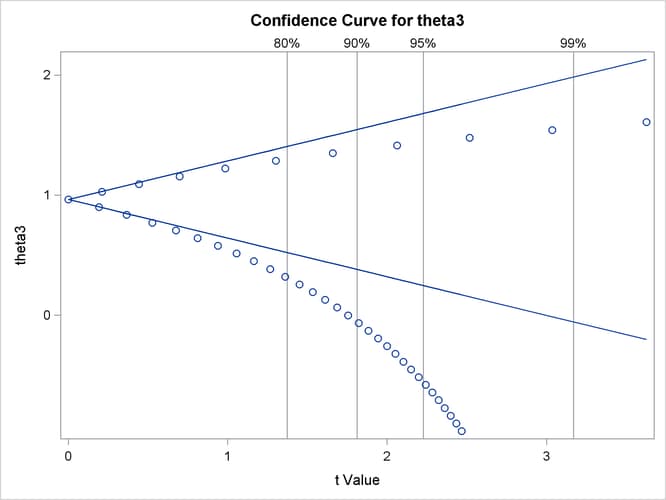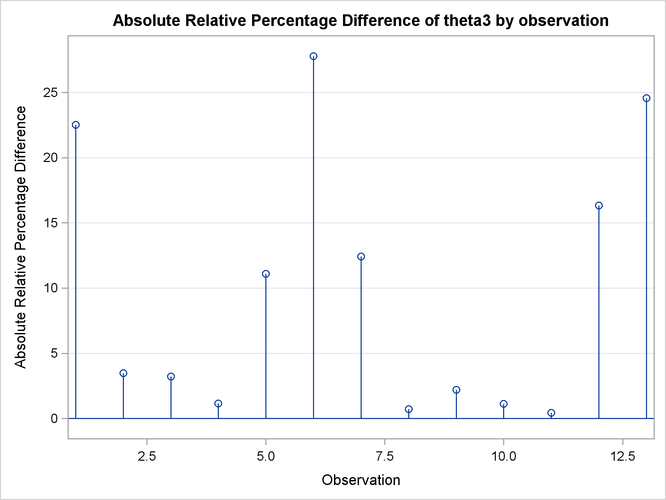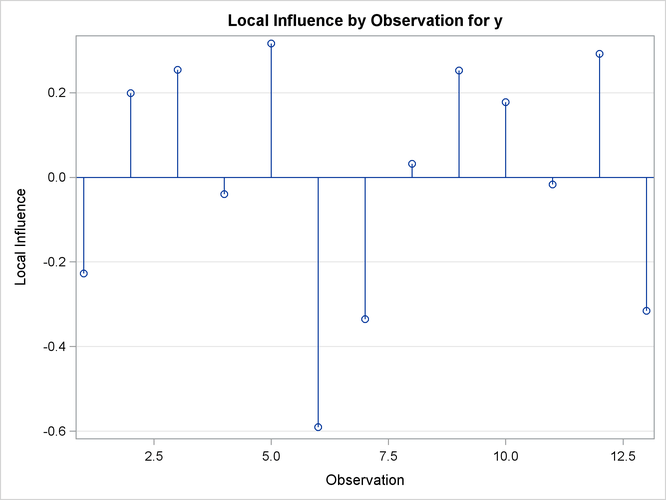The NLIN Procedure
- Overview
-
Getting Started

-
Syntax

-
Details
 Automatic DerivativesMeasures of Nonlinearity and DiagnosticsMissing ValuesSpecial VariablesTroubleshootingComputational MethodsOutput Data SetsConfidence IntervalsCovariance Matrix of Parameter EstimatesConvergence MeasuresDisplayed OutputIncompatibilities with SAS 6.11 and Earlier Versions of PROC NLINODS Table NamesODS Graphics
Automatic DerivativesMeasures of Nonlinearity and DiagnosticsMissing ValuesSpecial VariablesTroubleshootingComputational MethodsOutput Data SetsConfidence IntervalsCovariance Matrix of Parameter EstimatesConvergence MeasuresDisplayed OutputIncompatibilities with SAS 6.11 and Earlier Versions of PROC NLINODS Table NamesODS Graphics -
Examples

- References
The following model, taken from Clarke (1987), demonstrates the benefits of parameter profiling and confidence curves to identify the nonlinear characteristics of parameters that occur in the model. The profiling is also augmented with a plot that shows the influence of each observation on the parameter estimates.
The model takes the form
The data set used in this example is taken from Clarke (1987). The following DATA step creates this data set:
data clarke1987a; input x y; datalines; 1 3.183 2 3.059 3 2.871 4 2.622 5 2.541 6 2.184 7 2.110 8 2.075 9 2.018 10 1.903 11 1.770 12 1.762 13 1.550 ;
The model is fit with the following statements in the NLIN procedure:
ods graphics on;
proc nlin data=clarke1987a plots(stats=none)=diagnostics;
parms theta1=-0.15
theta2=2.0
theta3=0.80;
profile theta3 / range = -6 to 2 by 0.2 all;
model y = theta3 + theta2*exp(theta1*x);
run;
ods graphics off;
The profile t plot, Output 63.7.1, for parameter ![]() shows a definite deviation from the linear reference line that has a slope of 1 and passes through the origin. Hence, Wald-based
inference for
shows a definite deviation from the linear reference line that has a slope of 1 and passes through the origin. Hence, Wald-based
inference for ![]() is not appropriate. The confidence curve for
is not appropriate. The confidence curve for ![]() validates this conclusion.
validates this conclusion.
Output 63.7.2 shows the confidence curve for ![]() . You can see that there is a significant difference between the Wald-based confidence interval and the corresponding likelihood-based
interval. In such cases, the likelihood-based intervals are preferred because their coverage rate is much closer to the nominal
values than the coverage rate of the Wald-based intervals (Donaldson and Schnabel, 1987; Cook and Weisberg, 1990). Furthermore, this example shows that the adequacy of a linear approximation with regards to a certain parameter cannot
be inferred directly from the model. If it could,
. You can see that there is a significant difference between the Wald-based confidence interval and the corresponding likelihood-based
interval. In such cases, the likelihood-based intervals are preferred because their coverage rate is much closer to the nominal
values than the coverage rate of the Wald-based intervals (Donaldson and Schnabel, 1987; Cook and Weisberg, 1990). Furthermore, this example shows that the adequacy of a linear approximation with regards to a certain parameter cannot
be inferred directly from the model. If it could, ![]() , which enters the model linearly, would have a completely linear behavior. For a detailed discussion about this issue, see
Cook and Weisberg (1990).
, which enters the model linearly, would have a completely linear behavior. For a detailed discussion about this issue, see
Cook and Weisberg (1990).
Finally, Output 63.7.3 depicts the influence of each observation on the value of ![]() . Observations 6 and 13 have the most influence on the value of this parameter. The plot is generated using the leave-one-out
method and should be contrasted with the local influence plot, Output 63.7.4, which is based on assessing the influence of an additive perturbation of the response variable.
. Observations 6 and 13 have the most influence on the value of this parameter. The plot is generated using the leave-one-out
method and should be contrasted with the local influence plot, Output 63.7.4, which is based on assessing the influence of an additive perturbation of the response variable.



